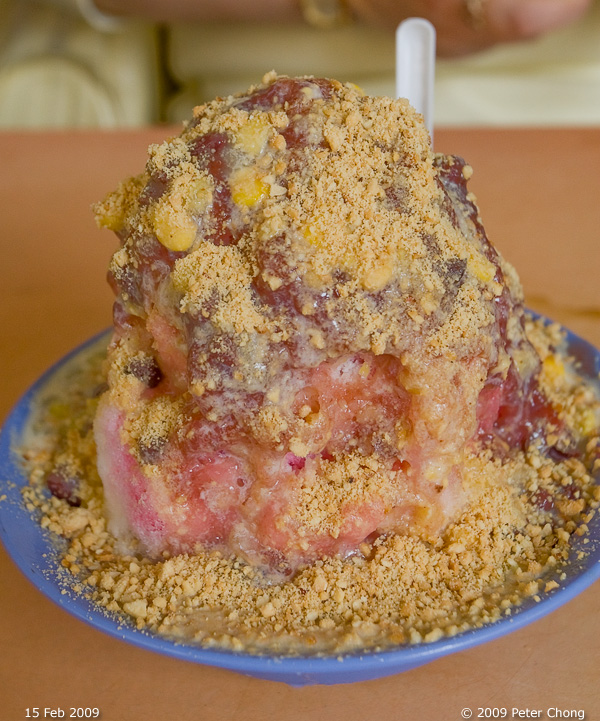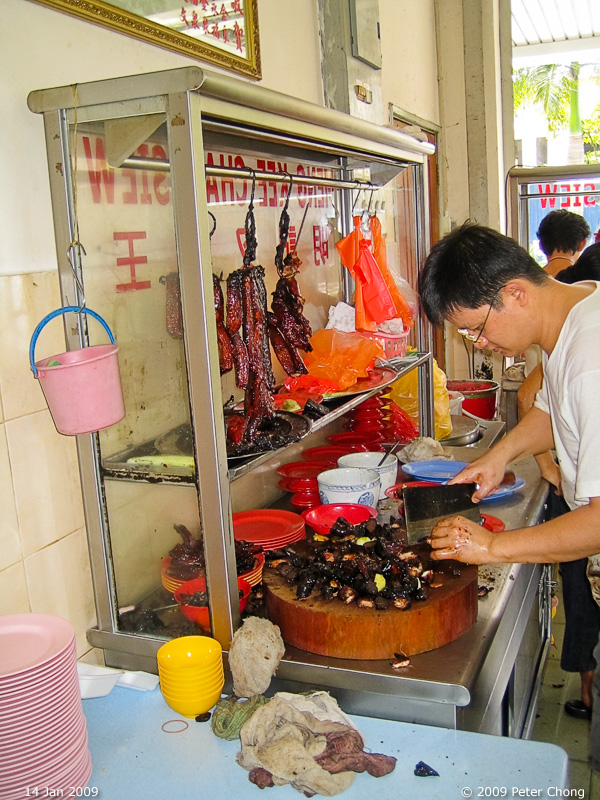ieat has blogged about Damien D'Silva and his Big D'Grill when he was still in Bedok South...but this year, Damien moved his stall into another coffee shop, but this time in Holland Drive...in the very same coffee shop, and almost right next door to Ricky of the XO Fish Bee Hoon Cze Char fame.
A group of 14 ieaters gathered by Holybro decended on the coffeeshop one Monday evening, and did what ieaters do best...eat.
We started with a trio of Italian inspired dishes...all pasta.
First, Crab meat linguini
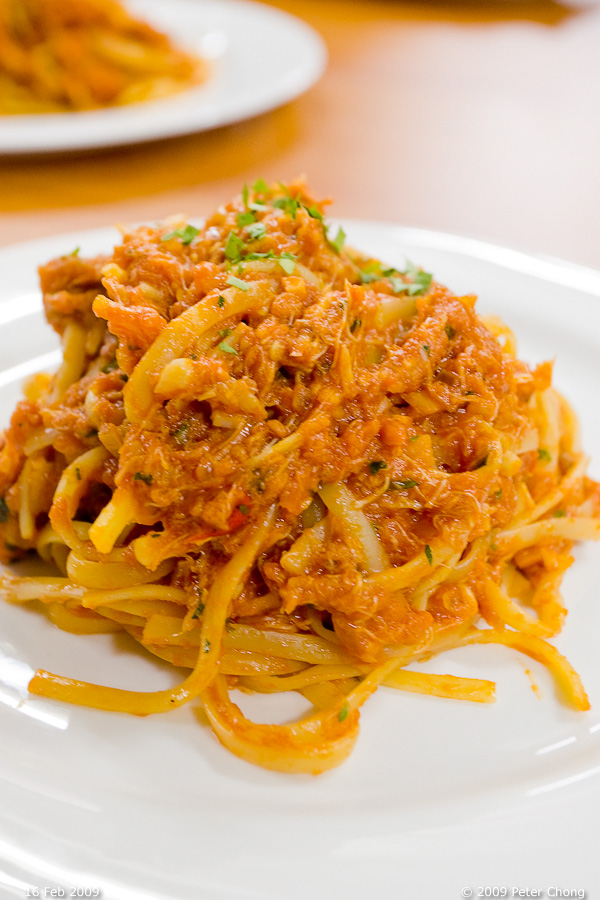
The pasta is home made, and fresh. I would have preferred the pasta to be al dente, and firmer to the bite, like they serve it in Italy. In one of my conversations with chefs in Italy, they told me that in fresh pasta was only used for the dumplings like gnocci, et al, and for the traditionalist never for spaggetti, fetucinni, linguini, because in order for the firmness required to qualify as al dente, the pasta needed to have been dessicated, and rehydrated only just so. As with canned tomatos, the method originally intended only to preserve and lengthen the shelf life of food, adds and enhances the flavour and quality of the food. Canned tomatos, and dried pasta is indeed superior in taste and texture than their fresh cousins.
Circuiteously, this is my way of saying that the linguini was too soft. The tomato crab sauce was very good...it showed off the subtle taste of the crab meat very well.
Next pasta was the bacon carbonara

This was the winner. A favourite in our table (actually it tied with the crabmeat linguini)...we had 2 tables joined together like a figure of 8, and had two sets of each dish. The carbonara sauce was thick, rich, flavourful. The eggy flavour was well infused with the cream, and the sauce was just enough to cling onto the spagetti. My Italian friends - the el Professories Landi - Massi and Francesca, often lament that because of the typical Singaporean kiasu attitude, we demand too much sauce in our pasta. Its called sauce and not gravy for a reason, so the Italians demand not too much of it. The test is that when you pick up the pasta, and finish off the plate, the plate should be clean...rather dry of sauce, and not have gravy that you then drink up like a soup.
The spagetti was again the same texture...too soft, but the sauce was magic. The pieces of bacon was generous in size and number, and added a further dimension to this dish.
Tagliatale Ragu was next.

Ragu is the quintessential Italian pasta sauce. What many of us know as Spagetti Bolognaise is known as ragu in Italy. Tomato based, it is cooked with ground beef (or another meat, but the Italians prefer beef). Damien's version had ground beef and veal.
On our table, this was received with mixed reviews. Some felt it was wonderful, I thought it was rather ordinary.
Next up, the Western...two of the piéce de resistance the kurobuta pork chops and the wagyu.

The kurobuta drew ooos and ahha from the table as it was served. It had already been sliced, and one can see the pink insides peeking out fromt he nicely browned exterior.
Sink your teeth into it, and you know why the Japanese and the world now come and pay homage to the humble Berkshire pigs...the meat was sublime. Tender to a fault, it was flavourful, each bite bursting with umami sending small torrent after torrent of pleasure to the brain. This was comfort food.

My slice shown above...note the generous fat, and the wonderfully cooked lean part of the meat. This was my absolute favourite of the evening.
Next up, Blackmoore Fullblood wagyu, intercostal cut:

The Blackmoore farm in Australia was one of the original wagyu farms. David and Julie Blackmoore, who own the farm are obsessed with their beef. They only produce full blood wagyu. Wagyu are Japanese cattle - wa meaning traditional Japanese, and gyu meaning beef. Traditional strains in Japan are the Black breed's famous breeding strains: Tajima from Hyogo Prefecture, Itozakura from Shimane Prefecture, and Kedaka from Tottori Prefecture are selected and bred in Australia by the Blackmoores. Fullblood wagyu means that both parents are wagyu. Thouroughbred means that only the steer (father) is wagyu. The sperm of the wagyu is inseminated into Angus or Hereford, and the offspring is known as thouroughbred. See their website for more info.
The wagyu presented for tasting by Damien was from the intercostal of the cattle...I am not sure if this is the superior cut or not, but I am impressed by a chef who is obsessed enough to know and describe his meat by the cut. The intercostals are the muscles between the ribs, and I guess not used for hard work, but only to expand and contract the ribcage. I would imagine it to be very tender.
It was not clear if the meat had been aged, but tasting the meat, I suspect not, and if it had some form of aging, was wet aged. See my earlier blog on beef aging.
The meat was very tender, but did not have any nutty taste that is characteristic of dry aging. The flavour of the wagyu was strong and sufficient, and there was no trace of an overpowering beefy taste. The cut was done medium rare, and the outsides midly brown. I would have preferred medium all the way through inside, and charred crisp on the outside.
I enjoyed the wagyu, but preferred the pork.
We also had a fish dish...but all of us were fussing over the pork and beef to pay much attention to the fish. I did taste it, and found it unremarkable.
Next round, we had Peranakan...this was not typical peranakan, but Damien style...so I guess this is Eurasian rather than peranakan. The Eurasians have developed their own cuisine, mixing western dishes with strong powerful spices and making the cuisine east meets west, like the people.
Some in the table found the beef rendang and buah keluak to be fascinating. I never fancied buah keluak - a difficult dish, where the buah keluak is rigrously cleaned, cooked, cracked and stewed for some 3 days. Damien puts in his special sambal for extra kick.
The beef rendang was quite tender, the spices ok. But frankly, my mom's beef rendang is superior.
We also had an intresting dish - the belimbing shrimps...belimbing is a fruit much like a small starfruit. Damien picks this from his mom's garden, and creates this dish...sour, a bit bitter. I didn't quite fancy it as well.
The only dish I had some feeling about in this round was the Bang Bang Chicken:

This was a chicken chop, but with a spicy twist. The crisply pan fried chicken, was done just right, and smothered with a special sauce which was so spicy and hot, that it even got me going...I would describe the spicy taste as peppery spicy and not chilli spicy. The effect was a numbing bite on the lips and tongue...what the Chinese would call ma la. I liked the dish, but this was not a dish to eat on its own...but to savour with a bowl of rice.
Finally dessert. Damien is famous for his bonet...

A chocolate pudding with caramel sauce. Whilst some found it to be wonderful, I found the dessert to be a bit one dimensional. The pudding was a bit overpowering in the dark chocolate. Not my preferred dessert.
Overall, the kurobuta and even the wagyu is worth a return visit. I also liked the carbonara pasta and the Bang Bang chicken. Interesting hawker western store, this one...quality ingredients, cooked with passion.
Read the reactions from the makan kakis who ate there, and oters at ieat forum
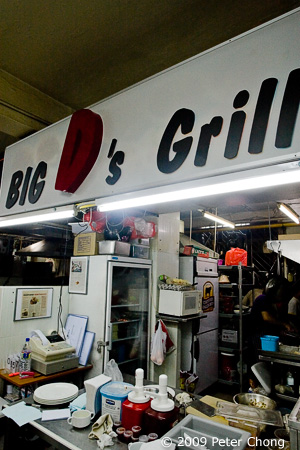
Big D's Grill
Block 46 Holland Drive
#01-359
Singapore 270046
Open daily from 12pm-2.30pm and 6pm-9.30pm, except Thursdays which is dinner only from 5.30pm till 9.30pm

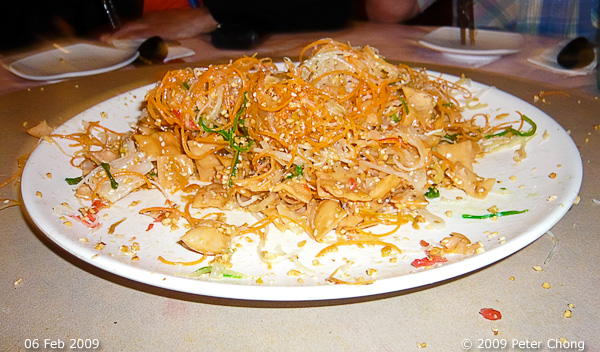








 Note the expression on the ladies' faces when presented with this GIANT piece of egg encrusted bread. The slice of bread must have been at least 2 inches thick. It had been sliced open, insides generously filled with peanut butter. And coated with egg. Pan fried till golden perfection, and served with a generous piece of butter and syrup. Not for the faint hearted, and certainly not for one who is not hungry.
Note the expression on the ladies' faces when presented with this GIANT piece of egg encrusted bread. The slice of bread must have been at least 2 inches thick. It had been sliced open, insides generously filled with peanut butter. And coated with egg. Pan fried till golden perfection, and served with a generous piece of butter and syrup. Not for the faint hearted, and certainly not for one who is not hungry. 



